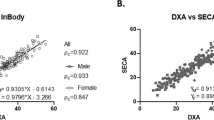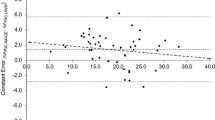Abstract
Objective: To investigate the accuracy of total body water (TBW) predicted by foot-to-foot bioelectrical impedance compared with a deuterium oxide dilution technique in oncology outpatients receiving radiotherapy.
Design: Cross-sectional design.
Setting: Two private Australian radiation oncology facilities.
Subjects: In all, 27 subjects (23 males; four females); mean age 62 (±15) y; mean BMI 26.2 kg/m2 (±3.6).
Interventions: TBW was measured using a deuterium oxide dilution technique and predicted using foot-to-foot bioelectrical impedance (Tanita Inc., Tokyo, Japan, Models TBF 410 and 300GS).
Results: The mean (s.d.) values for predicted and measured TBW was 41.5 (6.7) and 39.7 (8.7) l, respectively, indicating a mean bias to overestimation by the foot-to-foot impedance of 1.8 l. However, a significant negative correlation between the mean of the measurements of TBW and their difference (r=−0.40; P=0.04) indicates a progressive underestimation of TBW by foot-to-foot impedance as the water content of the body increases. The analysis of 95% limits of agreement (±2 s.d.) showed that for most individuals the TBW predicted by foot-to-foot impedance can vary as much as 12 l above or 8.6 l below the actual TBW measured by a deuterium oxide dilution technique.
Conclusion: There is good agreement between foot-to-foot bioelectrical impedance with a gold standard technique at the group level. However, the significant correlation between the difference of predicted and measured TBW, and the wide limits of agreement between the two methods, indicates that the use of foot-to-foot impedance in assessing TBW may lead to unacceptable error in individuals.
Sponsor: The Wesley Research Institute.
This is a preview of subscription content, access via your institution
Access options
Subscribe to this journal
Receive 12 print issues and online access
$259.00 per year
only $21.58 per issue
Buy this article
- Purchase on Springer Link
- Instant access to full article PDF
Prices may be subject to local taxes which are calculated during checkout


Similar content being viewed by others
References
Abbott R & Davies P (2001): Validation of foot-to-foot bioelectrical impedance in 6- to 10-year old children. In Body Composition Assessment in Children and Adolescents, eds T Jurimae & A Hills. pp 168–175 Karger, Basel.
Barber MD, Ross JA, Voss AC, Tisdale MJ & Fearon KC (1999): The effect of an oral nutritional supplement enriched with fish oil on weight-loss in patients with pancreatic cancer. Br. J. Cancer 81, 80–86.
Batterham M, Tapsell L & Jenkins A (2002): A comparison of bioelectrical impedance and near infra-red interactance with dual energy X-ray absorptiometry for the determination of body fat. Nutr. Diet. 59, 120–126.
Bauer J, Capra S, Davies PS, Ash S & Davidson W (2002): Estimation of total body water from bioelectrical impedance analysis in patients with pancreatic cancer — agreement between three methods of prediction. J. Hum. Nutr. Diet. 15, 185–188.
Baumgartner R, Chumlea W & Roche A (1989): Estimation of body composition from bioelectrical impedance of body segments. Am. J. Clin. Nutr. 50, 221–226.
Bell NA, McClure PD, Hill RJ & Davies PS (1998): Assessment of foot-to-foot bioelectrical impedance analysis for the prediction of total body water. Eur. J. Clin. Nutr. 52, 856–859.
Bland JM & Altman DG (1986): Statistical methods for assessing agreement between two methods of clinical measurement. Lancet 1(8476), 307–310.
National Institutes of Health Technology Assessment Conference Statement, Bioelectrical impedance analysis in body composition measurement: Dec 12–14, (1994). Am. J. Clin. Nutr. (1996) 64(Suppl), 524S–532S.
Cable A, Nieman DC, Austin M, Hogen E & Utter AC (2001): Validity of leg-to-leg bioelectrical impedance measurement in males. J. Sports Med. Phys. Fitness. 41, 411–414.
Davies P (1992): Assessment of body composition in the Prader–Willi syndrome using bioelectrical impedance. Am. J. Med. Gen. 44, 75–78.
Hainer V, Kunesova M, Parizkova J, Stich V, Horejs J & Muller L (1995): Body fat assessment by a new bipedal bioimpedance instrument in normal weight and obese women. Sbornik Lekarsky. 96, 249–256.
Halliday D & Miller AG . (1977): Precise measurement of total body water using trace quantities of deuterium oxide. Biomed. Mass Spectrom. 4, 82–87.
Heymsfield SB, Wang Z, Visser M, Gallagher D & Pierson Jr RN (1996): Techniques used in the measurement of body composition: an overview with emphasis on bioelectrical impedance analysis. Am. J. Clin. Nutr. 64(Suppl), 478S–484S.
Hoffer EC, Meador CK & Simpson DC (1969): Correlation of whole-body impedance with total body water volume. J Appl Physiol: Respi. Environ. Exerc. Physiol. 27, 531–534.
Houtkooper LB, Lohman TG, Going SB & Howell WH (1996): Why bioelectrical impedance analysis should be used for estimating adiposity. Am. J. Clin. Nutr. 64(Suppl), 436S–448S.
Jartti L, Hakanen M, Paakkunainen U, Raittinen P & Ronnemaa T (2000): Comparison of hand-to-leg and leg-to-leg bioelectric impedance devices in the assessment of body adiposity in prepubertal children. the STRIP study. Special Turku coronary Risk factor Intervention Project. Acta Paediatr. 89, 781–786.
Jebb SA, Cole TJ, Doman D, Murgatroyd PR & Prentice AM (2000): Evaluation of the novel Tanita body-fat analyser to measure body composition by comparison with a four-compartment model. Br. J. Nutr. 83, 115–122.
Lukaski HC, Bolonchuk WW, Hall CB & Siders WA (1986): Validation of tetrapolar bioelectrical impedance method to assess human body composition. J. Appl. Phys. 60, 1327–1332.
McMillan DC, Watson WS, Preston T & McArdle CS (2000): Lean body mass changes in cancer patients with weight loss. Clin. Nutr. 19, 403–406.
Nunez C, Gallagher D, Visser M, Pi-Sunyer FX, Wang Z & Heymsfield SB (1997): Bioimpedance analysis: evaluation of leg-to-leg system based on pressure contact footpad electrodes. Med. Sci. Sports Exerc. 29, 524–531.
Ottery FD (1996): Definition of standardized nutritional assessment and interventional pathways in oncology. Nutrition 12(Suppl), S15–S19.
Powell LA, Nieman DC, Melby C, Cureton K, Schmidt D, Howley ET, Hill JO, Mault JR, Alexander H & Stewart DJ (2001): Assessment of body composition change in a community-based weight management program. J. Am. Coll. Nutr. 20, 26–31.
Prosser S & Scrimgeour C (1995): High precision determination of 2H/1H in H2 and H2) by continuous flow isotope ratio mass spectrometry. Anal. Chem. 67, 1992–1997.
Prosser SJ, Brookes ST, Linton A & Preston T (1991): Rapid, automated analysis of 13C and 18O of CO2 in gas samples by continuous-flow, isotope ratio mass spectrometry. Biol. Mass Spectrom. 20, 724–730.
Schoeller DA, van Santen E, Peterson DW, Dietz W, Jaspan J & Klein PD (1980): Total body water measurement in humans with 18O and 2H labelled water. Am. J. Clin. Nutr. 33, 2686–2693.
Segal K, Loan PF & Hodgdon J (1987): Estimation of lean body mass by bioelectrical impedance: a multicenter validation study. Med. Sci. Sports Exerc. 19, S39.
Sheng HP & Huggins RA (1979): A review of body composition studies with emphasis on total body water and fat. Am. J. Clin. Nutr. 32, 630–647.
Simons JP, Schols AM, Westerterp KR, ten Velde GP & Wouters EF (1995): The use of bioelectrical impedance analysis to predict total body water in patients with cancer cachexia. Am. J. Clin. Nutr. 61, 741–745.
Simons JP, Schols AM, Westerterp KR, Ten Velde GP & Wouters EF (1999): Bioelectrical impedance analysis to assess changes in total body water in patients with cancer. Clin. Nutr. 18, 35–39.
Tchekmedyian NS, Zahyna D, Halpert C & Heber D (1992): Assessment and maintenance of nutrition in older cancer patients. Oncology (Huntington). 6(Suppl), 105–111.
Tyrrell VJ, Richards G, Hofman P, Gillies GF, Robinson E & Cutfield WS (2001): Foot-to-foot bioelectrical impedance analysis: a valuable tool for the measurement of body composition in children. Int. J. Obes. Relat. Metab. Disord. 25, 273–278.
Utter AC, Nieman DC, Ward AN & Butterworth DE (1999): Use of the leg-to-leg bioelectrical impedance method in assessing body-composition change in obese women. Am. J. Clin. Nutr. 69, 603–607.
Utter AC, Scott JR, Oppliger RA, Visich PS, Goss FL, Marks BL, Nieman DC & Smith BW (2001): A comparison of leg-to-leg bioelectrical impedance and skinfolds in assessing body fat in collegiate wrestlers. J. Strength Cond. Res. 15, 157–160.
van Bokhorst-de van der S, van Leeuwen PA, Kuik DJ, Klop WM, Sauerwein HP, Snow GB & Quak JJ (1999): The impact of nutritional status on the prognoses of patients with advanced head and neck cancer. Cancer 86, 519–527.
Xie X, Kolthoff N, Barenholt O & Nielsen SP (1999): Validation of a leg-to-leg bioimpedance analysis system in assessing body composition in postmenopausal women. Int. J. Obes. Relat. Metab. Disord. 23, 1079–1084.
Acknowledgements
We thank Dr Diana Battistutta for statistical advice and Kelli Edmiston for urine sample analyses.
Author information
Authors and Affiliations
Contributions
Guarantor: E Isenring.
Contributors: EI was the main author of the manuscript, initiated the study, collected data and carried out the statistical analysis and interpretation. JB initiated the study, assisted in the statistical analysis, interpretation and writing of the manuscript. SC initiated the study, supervised the project, assisted in the statistical analysis, interpretation and writing of the manuscript. PD assisted in the statistical analysis, interpretation and writing of the manuscript.
Rights and permissions
About this article
Cite this article
Isenring, E., Bauer, J., Capra, S. et al. Evaluation of foot-to-foot bioelectrical impedance analysis for the prediction of total body water in oncology outpatients receiving radiotherapy. Eur J Clin Nutr 58, 46–51 (2004). https://doi.org/10.1038/sj.ejcn.1601744
Received:
Revised:
Accepted:
Published:
Issue Date:
DOI: https://doi.org/10.1038/sj.ejcn.1601744
Keywords
This article is cited by
-
Bioelectrical impedance validation studies: alternative approaches to their interpretation
European Journal of Clinical Nutrition (2013)
-
Comparing measures of fat-free mass in overweight older adults using three different bioelectrical impedance devices and three prediction equations
The journal of nutrition, health & aging (2012)
-
Implications of the variability in time to isotopic equilibrium in the deuterium dilution technique
European Journal of Clinical Nutrition (2007)
-
Nutrition intervention is beneficial in oncology outpatients receiving radiotherapy to the gastrointestinal or head and neck area
British Journal of Cancer (2004)



